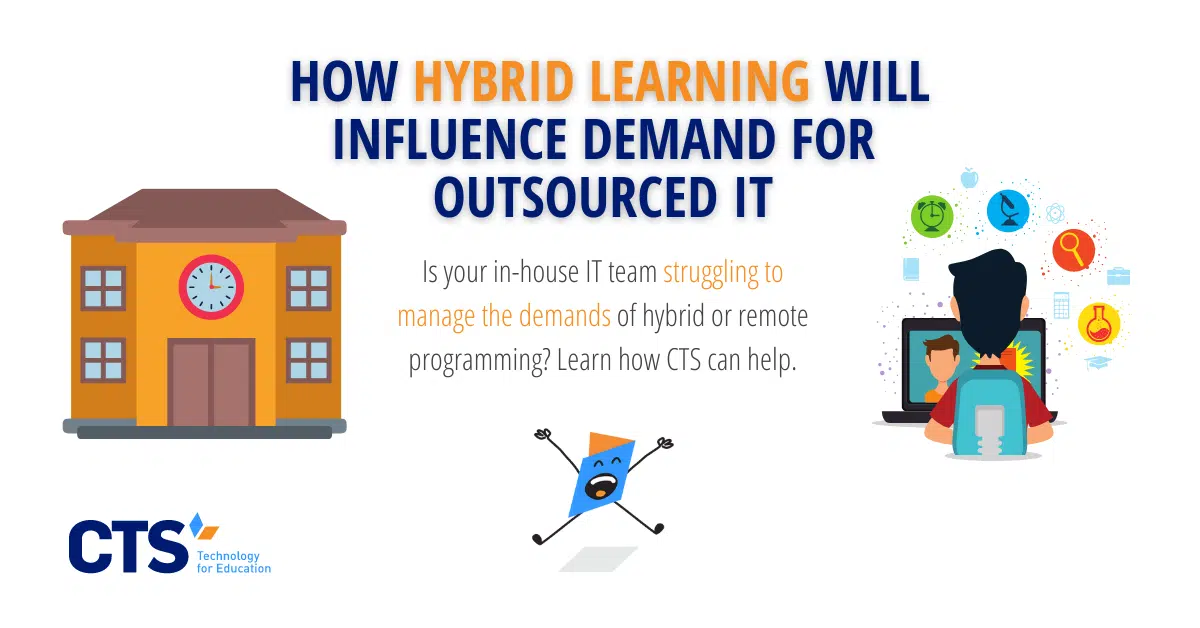Hybrid learning creates additional responsibilities for in-house IT teams.
Even before the widespread adoption of remote or hybrid learning programs, in-house IT teams faced dozens of competing priorities. From daily troubleshooting to hardware procurement and device management, in-house IT team members confront a lengthy to-do list that often exceeds their team’s capacity.
In many instances, a single individual at a school or non-profit is responsible for the full range of the organization’s IT programming. That means, for example, that the individual needs to stay on top of device management and repair, address daily troubleshooting tickets in a timely manner, plan ahead for organization-wide events, and think through the school or non-profit’s technology needs for the following year.
Overseeing effective hybrid learning programs presents yet another challenge. As schools and non-profits shift to fully remote or hybrid programs, in-house IT teams will increasingly find themselves pulled between the in-person demands of their organization’s IT programming and the parallel needs of their remote or hybrid constituencies. As a result, it often makes sense—now more than ever—for schools and non-profits with remote or hybrid programs to shift to an outsourced, managed IT, model.
Schools and non-profits with in-house IT teams may find their existing personnel can’t manage the demands of hybrid learning.
As technology plays an increasingly central role in school and non-profit programming, organizations will need additional personnel to manage their IT needs. Organizations with in-house teams, in particular, are likely to face competing demands for their time and attention. While a single IT team member may make sense for a smaller, less established non-profit, the organization’s continued growth will inevitably test that proposition, particularly if the school or non-profit begins offering a remote or hybrid option.
While a single team member may be able to manage the entirety of the organization’s in-person programming—which in and of itself is no easy feat—it’s usually not fair to assume that individual can also monitor and troubleshoot the organization’s remote or hybrid programming as well. When a Zoom link isn’t working, a content management system malfunctions, or a projector bulb blows out; the in-house IT member is pulled in multiple directions at once.
Not only is addressing each task urgent, but the individuals who submit tickets for such issues rarely understand the IT team’s constraints. When it takes more than a few minutes for an IT team member to address a particular issue, the individual who submitted the ticket doesn’t understand that the delay was likely due to another, equally urgent task the team member needed to address.
Even high-functioning in-house IT teams may need supplemental IT support.
Even the highest-functioning in-house IT team will almost certainly need supplemental support at some point. For instance, if the organization is conducting a large-scale event, it’s often not feasible to place the event’s entire IT burden on a single individual. Issues with audiovisual equipment and internet connectivity, for example, can derail an otherwise carefully planned event and demand the quick thinking of an IT team member. Suppose that team member is stretched between the competing priorities of in-person and hybrid programming. In that case, they are unlikely to triage the issue promptly, much less take the time to prevent it from occurring in the first place.
For this reason, it often makes sense for an in-house IT team to offload at least some of the demands of either day-to-day programming or event management to an external provider. Doing so ensures that the organization’s daily programming continues to run smoothly and relieves significant stress on individual IT team members.
Likewise, particularly complex IT projects might also exceed the technical know-how of an in-house IT team. Suppose the in-house team is already stretched thin between in-person and hybrid learning demands. In that case, outsourcing the project to an external provider often makes more sense than asking an in-house team member to spend valuable time studying up the project’s needs.
At CTS, we help schools and non-profits achieve their unique missions.
Our team has worked with more than 60 schools and non-profit organizations across the United States to improve their technology programming. As remote and hybrid learning options continue to spread, organizations will need technology providers who can manage the full breadth of their organization’s IT needs.
From daily troubleshooting and planning to device management and procurement, our team has the track record and technical know-how to ensure your school or non-profit’s technology adds value to your organization’s programming. Working with a managed IT provider like CTS lets your team rest easy, knowing that common technology issues won’t undermine your organization’s day-to-day operations.
Contact us today to learn more about our services and how we can help your organization accomplish its unique mission.




